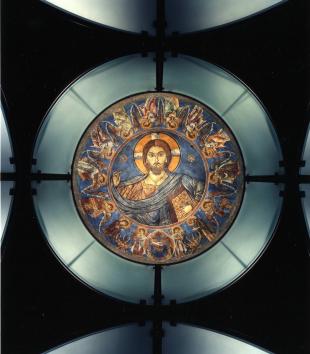Essays are narratives of varying lengths that engage in extended analysis of multiple images, objects, monuments, buildings, or spaces.
Essays
This special joint issue is published with The Journal of Southern Religion (JSR). The journals issued a call for papers together in 2017 and are pleased to publish these four peer-reviewed articles, two editorial introductions, and one editorial reflection. In his editorial reflection, Bill Ferris considers his own history with southern religion and material culture. Jason Young and Louis P. Nelson offer introductions for the four articles, with additional reflection on the state of the field.
 Horseshoe Crosses and Muddy Boots: Material Culture and Rural Masculinity in Cowboy Churches
Horseshoe Crosses and Muddy Boots: Material Culture and Rural Masculinity in Cowboy Churches
In a large pasture in West Texas, thirty-five men and women sit mounted on horseback and forty more stand around them. Sitting astride a horse in front of them is their pastor, next to another man holding a large American flag. He reads to them from the Bible of the wondrous changes brought by the Lord and then invites them to church the next day. With this simple invocation, the pasture roping at the local cowboy church is now underway.
 Uncle Tom’s Bibles: Bibles as Visual and Material Objects from Antebellum Abolitionism to Jim Crow Cinema
Uncle Tom’s Bibles: Bibles as Visual and Material Objects from Antebellum Abolitionism to Jim Crow Cinema
Stowe’s deployments of bibles and artistic representations of them in illustrated editions offered a conservative abolitionism that emphasized the potential for peace among former slaves and masters. . . . bibles in the afterlives of Uncle Tom’s Cabin continued to offer moderation when it came to issues of race and racial interactions.
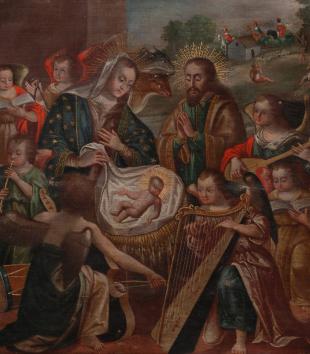 Audible Paintings: Religious Music and Devotion to the Infancy of Christ in the Art of the Viceroyalty of Peru
Audible Paintings: Religious Music and Devotion to the Infancy of Christ in the Art of the Viceroyalty of Peru
Paintings are silent, but not to those who know how to listen. Some paintings appeal to the sense of hearing in order to stimulate the beholder’s emotional engagement. For eighteenth-century nuns living in the Viceroyalty of Peru, paintings could evoke Latin polyphony or villancicos, songs in the vernacular performed in sacred contexts.
 Elijah Pierce and Material Conversions
Elijah Pierce and Material Conversions
Obey God and Live (Vision of Heaven) is Elijah Pierce’s personal conversion narrative. In this piece of wood he depicted the definitive episode of his own spiritual autobiography, an event in his past that he understood to (re)organize, interpret, and frame his entire life.
 The Canopy Tomb of Edward Shippen Burd
The Canopy Tomb of Edward Shippen Burd
This American monument may even present an understudied alternative vision of the afterlife—one incorporating an intermediate phase just after death—that runs through nineteenth-century Protestant and Anglo-Episcopal sources.
MAVCOR began publishing Conversations: An Online Journal of the Center for the Study of Material and Visual Cultures of Religion in 2014. In 2017 we selected a new name, MAVCOR Journal. Articles published prior to 2017 are considered part of Conversations and are listed as such under Volumes in the MAVCOR Journal menu.
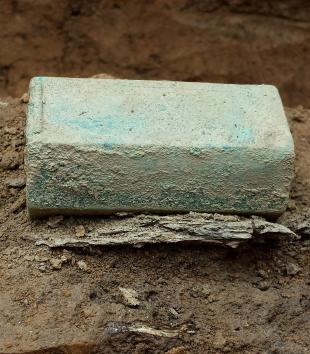 Jamestown’s Relics: Sacred Presence in the English New World
Jamestown’s Relics: Sacred Presence in the English New World
A remarkable reliquary helps us imagine new possibilities around the earliest English settlement in North America.
 Julian Voss-Andreae, Angel of the West
Julian Voss-Andreae, Angel of the West
The power to protect against “nature” now dwells in the human scientific-technological skills mastered by a certain culture, whose prowess enables it to discover these new (meta)physical angels and harness their powers.
 Fabric of Devotion: William Quiller Orchardson’s The Story of a Life and Women Religious in Victorian Britain
Fabric of Devotion: William Quiller Orchardson’s The Story of a Life and Women Religious in Victorian Britain
Produced in a Christian tradition for the viewing pleasure of the London art world's cultured audiences, William Quiller Orchardson’s The Story of a Life alludes to the controversies and contentions of religious life and women’s roles in mid-nineteenth-century Britain.
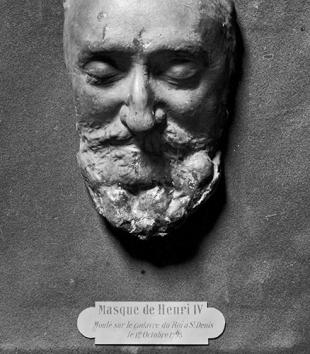 The Revolutionary Exhumations at St-Denis, 1793
The Revolutionary Exhumations at St-Denis, 1793
The French Republic's July 1793 exhumation of the royal tombs intertwines not only contemporary religion and politics but also religious traditions with contemporary intellectual debate.
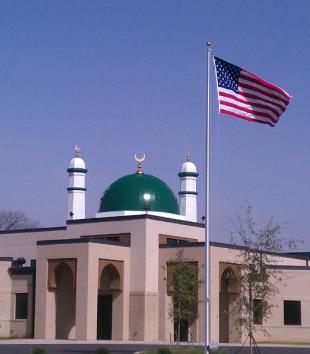 The Politics of (Mere) Presence: The Islamic Center of Murfreesboro, Tennessee
The Politics of (Mere) Presence: The Islamic Center of Murfreesboro, Tennessee
The old Islamic Center of Murfreesboro was not, it seems, meant to be seen at all. A yearning to blend in, be ordinary, unremarkable, even overlooked, would, as I later discovered, inflect the architectural presentiments of the old and new centers alike, and provide an apt metaphor for the struggles that have confronted the Islamic community in this small city in central Tennessee.
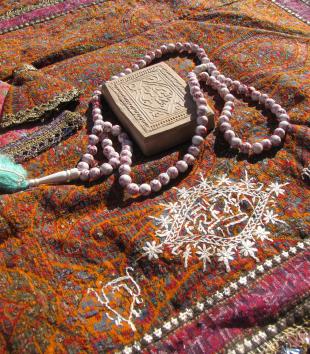 Praying through the senses: The Prayer Rug/Carpet and the Converging Territories of the Material and the Spiritual
Praying through the senses: The Prayer Rug/Carpet and the Converging Territories of the Material and the Spiritual
Consumption as a material practice changes religious meanings and practices, and value comes to be invested in certain religious objects, rituals, and ideas rather than others.
 Martin Puryear, Desire
Martin Puryear, Desire
The world of handmade objects and manual labor turns strange in Puryear's Desire, and in this way, the ordinary becomes—here is list of options, choose one—estranged, uncanny, defamiliarized.
 Art That Breathes: Lewis deSoto’s Paranirvana (self-portrait)
Art That Breathes: Lewis deSoto’s Paranirvana (self-portrait)
Unlike its solid stone predecessor, deSoto’s work, made from painted polyethylene cloth, is hollow, filled only by air from a fan that keeps the sculpture inflated. The resemblance to the reclining Buddha is nonetheless remarkable, from the curls of hair to the folds of the robe, the one exception being that deSoto superimposed his own facial features, complete with goatee, on this Buddha.
 Repositioning Plautilla Nelli’s Lamentation
Repositioning Plautilla Nelli’s Lamentation
My favorite underrated work of art is the Lamentation by Suor Plautilla Nelli (1523-1588), the first woman artist in Renaissance Florence with an oeuvre to go with her name. This large altar painting was created for the Dominican convent of Saint Catherine of Siena, where it stood, nearly ten feet high, on a prominent altar in the convent’s public church.
